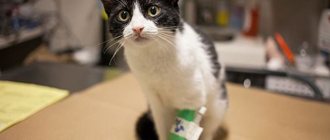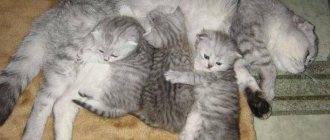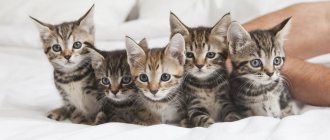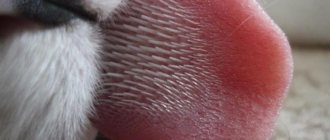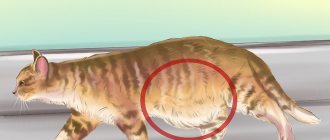5765Pavel
Pregnancy termination in cats is carried out in two cases: by the owner’s decision and with the recommendations of a veterinarian. Abortion can be stressful for the animal; it may be better to let the cat give birth, because there is a risk of infertility. Most often it is formed during the termination of the first pregnancy. If a veterinarian recommends an abortion for a pet, based on the fact that the cat is weak and will not be able to give birth, then in order to save the pet’s life it is worth taking the risk of terminating the pregnancy.
Causes of miscarriages
There are two general groups of reasons that can cause spontaneous abortion in a cat:
- primary, caused by genetic characteristics and various infections;
- secondary, caused by environmental factors and the location of the placenta.
Primary
The primary causes, as you might guess, are very difficult to combat, since traits inherent in genetics are hardly amenable to correction. Meanwhile, there are breeds whose females are predisposed to miscarriages in the absence of visible health problems: such breeds include Persian and Himalayan cats.
Primary miscarriage is very difficult to predict and almost impossible to predict.
When it comes to infections, the pet owner already has more control over the situation. You can avoid miscarriage in the event of an infectious infection by taking care of timely vaccination of the cat before mating and pregnancy, as well as good living conditions for the animal.
Secondary
The secondary causes of miscarriages in cats include three main factors:
- placenta previa. Placenta previa refers to its incorrect location in which the placenta partially or completely covers the uterine os. It should be noted that this phenomenon is rare and is more often observed in cats that have already given birth once;
- injuries. Regarding injuries, everything is very clear: any bodily injury inflicted on a cat during pregnancy can threaten both its life and the life of the fetus;
- impaired blood circulation between the uterus, placenta and embryos. Poor circulation can have many causes - from poor nutrition to severe and prolonged stress.
Secondary miscarriages often occur due to injury
In addition to primary and secondary, some veterinarians also identify an additional group of causes, which includes the following factors:
- metabolic disorders in the animal's body;
- intense experiences;
- inbreeding (crossing of closely related individuals);
- inappropriate age of the animal (it is advisable to allow females to mate that have already reached full physiological maturity and do not show signs of aging. The age of such cats ranges from one to six years).
Before mating animals, it is necessary to carefully select a partner suitable for the female
Stress factors
Not only women, but also cats experience early pregnancy, which negatively affects the condition of future babies. Stress can lead to the need for an abortion. A similar condition occurs in pets when the walking or feeding regime is disturbed. Cats that are subjected to improper or harsh training also face the problem of stress while bearing kittens.
Veterinarians focus the attention of owners on the fact that during pregnancy, even a minor detail can cause a spontaneous abortion in a pet, so it is worth paying special attention to the cat, surrounding it with care and warmth, so as not to cause a miscarriage.
Often a tragedy in an animal’s life occurs due to the accumulation of gases in its abdominal cavity.
With an abundant accumulation of gases in the gastrointestinal tract, the cat often aborts in the early stages of pregnancy. This is due to the fact that gas formation puts negative pressure on the uterus, as a result of which the myometrium tenses and puts pressure on the walls of the organ, provoking its tone. If a similar situation occurs at a later stage of gestation, then the cat experiences premature birth, due to which the babies are born premature or stillborn.
Veterinarians often observe that the female aborted due to the spread of pathogenic microflora in the body. When infected, fetuses become mummified, which leads to abortion, and the cat must be urgently rescued at a veterinary clinic, since there is a high probability of its death. If owners want to have offspring, then it is worth vaccinating the pet not after mating, but before it, in order to reduce the likelihood of infection during pregnancy.
Certain genetic disorders make the offspring unable to develop further.
- Genetic changes in fetal development that are incompatible with life. During fertilization, it happens that the egg chromosomes behave in an atypical way, as a result of which there is a high probability of fetal death.
- Lack of hormones in the cat's body. In such a case, it is difficult for the embryos to take root, which is why spontaneous abortion occurs.
- Impaired blood supply to the uterus or placenta.
- Inflammatory reaction in the cat's body. It doesn’t matter whether the organs of the reproductive system or other structures are inflamed, such disorders increase the chance of miscarriage in females.
- Impacts and other mechanical damage. If the cat is injured in the abdominal area, she may lose her unborn kittens.
- Use of certain drugs. Before giving your pet any medications, you should read the instructions for use and make sure that they are approved during pregnancy.
Veterinarians claim that a female may have an abortion if there are a large number of fetuses, and that the small pelvis and underdeveloped reproductive system can also affect such a disorder.
Etiology
Miscarriage, spontaneous abortion in cats, which leads to the death of embryos and fetuses, has a wide variety of etiologies. May occur due to primary or secondary causes. Complications can arise not only in the reproductive system, but also affect other internal organs in the cat’s body.
Among the most common reasons are:
- stress, strong emotional experiences;
- endocrine pathologies;
- metabolic disorders in the body;
- placental insufficiency;
- injuries, damage to the peritoneum, internal organs;
- inflammatory processes in the organs of the reproductive system;
- incorrect placement of fruits;
- poorly planned, close inbreeding;
- hormonal imbalance;
- infectious, viral, parasitic diseases.
Very often, spontaneous abortions in cats occur against the background of viral and bacterial diseases. Rhinotracheitis, panleukopenia, chlamydia, salmonellosis, and other acute infections can lead to fetal death in the early stages of pregnancy. Rickettsia, mycoplasmas, pathogenic fungi, and protozoan microorganisms can also cause miscarriage in cats.
Spontaneous abortion in furry pets occurs due to embryofetopathy (malformations, genetic abnormalities in the development of embryos, chromosomal defects), endometritis, pyometra, prolapse, torsion of horns, other pathologies of the uterus, as well as as a result of insufficient secretion of luteinizing hormone.
Severe hypothermia, invasive, non-contagious diseases can also provoke early expulsion of fetuses from the uterus.
In the early stages, it can be asymptomatic in females, since the embryos are not yet fully formed and the tissues are easily resorbed.
Possible outcomes include: mummification of the fetus, the birth of a dead, non-viable offspring, resorption of the fetus. In later stages, dead, mummified fetuses remain in the uterus until labor begins.
It is possible to determine the pathology of pregnancy in cats only after undergoing comprehensive diagnostics, as well as by the deterioration of the furry pet’s condition.
Owners should be alert to the following symptoms:
- increase in body temperature by 1-2 degrees;
- increased thirst;
- refusal to feed, loss of appetite;
- purulent, catarrhal discharge from the genitals;
- disruption of digestive processes;
- anxiety, depression, constant drowsiness;
- decreased activity, changes in behavioral manners.
When palpating the peritoneum, if the fruits are mummified, solid shapeless formations are felt. During maceration of already formed embryos, the fruits soften and the uterine tissue liquefies. On palpation, the uterine cavity is filled with a pasty mass.
Important! The death of fetuses during pregnancy in cats is accompanied by catarrhal, purulent-catarrhal inflammation occurring in the uterus. Metritis, pyometra, and endometritis are diagnosed in cats.
Abortion at home
Of course, the most radical, most effective and healthiest thing is castration-sterilization. The reproductive instinct is something that a cat cannot cope with on its own.
It is during these few periods of the year that she completely stops thinking, and all her desire and behavior is aimed at prolonging the race.
A cat comes into heat for the first time between 7 and 9 months of age.
The estrus period takes place in several stages, which can be determined by the following signs:
- Swelling of the reproductive organs;
- Frequent trips to the litter tray;
- Frequent licking of the pelvic area;
- Loss of appetite;
- Increased need for affection - the pet begins to intensively demand attention and rub against surrounding objects, falls on its back and rolls around, making purring sounds;
- Attempts to escape from home;
- The cat constantly meows, does it loudly and protractedly;
- The animal arches its back. Raises its tail and steps with its hind legs.
During this period, the pet’s mood deteriorates sharply, irritability and aggressiveness appear.
The cat wants to go for a walk. The pet owner does not enjoy this behavior either.
Cats reach final sexual maturity between 1 and 1.5 years.
Removing symptoms, as well as completely eliminating the urge to estrus, asking a cat that does not lead to pregnancy, is possible using 3 methods:
- The use of drops that reduce libido;
- Sterilization is a surgical procedure that involves partial or complete removal of the reproductive organs;
- Injections that reduce the reproductive instinct.
Immediately after administration of the drug, a slight local painful reaction is possible.
Contraceptive injections and pills, with a certain dosage, affect the cat’s hormonal levels in a short period of time, resulting in a delay in estrus.
The most effective and frequently used drugs are:
- Covinan – 2000 rubles for 20 ml;
- Depo-promon – 145 rubles per 1 ml;
- Depo-Provera – 120 rubles per 1 ml;
- Subcutaneous implants suprelorin – 5550 for 1 implant.
The drug most suitable for injection is selected individually, depending on the cat’s health condition and the financial capabilities of its owner.
The drug suprelorin is an implant inserted under the skin by a veterinarian
Chemical sterilization of a cat is a convenient option for reducing your pet’s sexual activity.
Injections are a gentle option for contraception and relieving symptoms of estrus; they also do not completely block the reproductive function of the body.
Before starting the procedure, the cat owner should consult a veterinary clinic and weigh all the positive and negative consequences of hormonal injections.
When an unsterilized fluffy beauty lives in the house, sooner or later the owner faces the question: what to do to prevent the cat from getting pregnant? This problem is relevant not only for novice breeders, but also for their more experienced colleagues.
Is it possible to abort a pet at home? On the one hand, there is nothing complicated about this, you need to give the animal medicine or give an injection, on the other hand, without the correct dose of the hormone, irreversible consequences for the animal can occur, even death.
We looked at possible options for abortion in cats. From all of the above, one conclusion can be drawn: any method of abortion is dangerous and fraught with consequences and must necessarily occur under the close supervision of a specialist.
Abortion in cats
In order to prevent unwanted pregnancy in your pet and the possible consequences of abortion, there are a huge number of methods and contraceptives. Modern veterinary medicine advises the use of hormonal injections and oral contraceptives.
Contraceptives come in the form of tablets and drops, and their effect is achieved by suppressing sexual arousal and preventing the onset of ovulation, in addition, these hormones calm and improve the functioning of the nervous system. A good veterinarian should choose the right contraceptive option.
But there are also disadvantages: it is very undesirable to use these drugs in nulliparous individuals and animals under five years of age, since the risk of developing serious diseases is high. Steroid sex hormones act exclusively on the animal’s brain, inhibiting sexual function, and therefore mating does not occur. Any uncontrolled use of hormonal drugs entails the risk of developing cancer, tumors and cysts.
Useful materials:
- Cutaneous horn
General description of the disease Cutaneous horn on the forehead or face (ICD 10 code - L57.0) -... - The cat has cancer Stages of mammary gland cancer in cats Like in humans, cat mammary cancer has ...
- Itching and odorless discharge Main causesBefore considering the factors that provoke the appearance of discharge that has a sour odor, it is necessary to immediately note...
It is not possible to perform a surgical termination of pregnancy like a human. Thus, if all embryos are surgically removed, the integrity of the cat’s internal organs will be compromised, which will lead to complications at best or death at worst. Therefore, you can apply styling.
This medical termination of pregnancy is divided into 3 types depending on the period:
- Immediately after mating. Estrogens are used. This hormone instantly prevents cat pregnancy by preventing the cat’s eggs from implanting into the wall of the uterus. Cats do not tolerate estrogen well. Therefore, it should be used only as a last resort, since after using it the cat will have to be sterilized.
- Halfway through pregnancy. Prostaglandins are used. Their use leads to miscarriage. So the cat gives birth to undeveloped embryos, and they die instantly once outside the uterus. The release of not all embryos during this procedure is dangerous. The remaining embryos in the uterus will decompose and rot, causing serious inflammation. Surgery will be necessary. When using this drug, the risk of disease of the uterus and related organs increases. Therefore, subsequent sterilization is recommended.
- Late pregnancy. Only glucocorticoids will help. They will provoke premature birth in the cat. The pet will give birth to already grown embryos, but not viable ones. This type of birth is dangerous for the cat and may require an emergency caesarean section.
The most effective termination of a cat's pregnancy is in the middle of its term. Since the effect of drugs that actively work in later stages has not been fully studied by specialists. No one guarantees that such an abortion will be safe.
How to terminate a cat's pregnancy
There are several abortion options for cats. Unfortunately, human abortion methods are not suitable for the feline family due to the anatomical structure of the uterus: it is impossible to surgically remove the fetuses without damaging the animal's uterus itself. But humanity has long stepped forward, thanks to which we can regulate the fertility of our animal.
It is worth warning that any method of termination for cats can lead to irreversible health problems , and therefore it is strongly recommended to monitor the reproductive cycle and use drugs that suppress fertility and prevent pregnancy.
Non-hormonal methods of abortion in cats
The only non-hormonal method of aborting a cat is complete sterilization. The doctor removes the uterus with the embryos in it and the ovaries through an incision. This method is suitable for those who do not want to raise offspring. But the longer the pregnancy, the more difficult the procedure is for your pet. Therefore, it is best to carry out complete sterilization without waiting until it occurs or as soon as possible.
Hormonal methods of abortion
Animals are given various hormonal drugs that prevent pregnancy from occurring. Estrogens are the most extreme method used in veterinary medicine. These hormones act on the fertilized egg and prevent it from attaching to the uterus. Estrogens are used immediately after mating and have a huge number of side effects for the animal.
After using this hormone only once, she will have to be sterilized, otherwise there is a high probability of developing various genitourinary diseases. Possible outcomes include suppression of brain function, which very quickly leads to death.
Abortion
In the early stages
Prostaglandins are hormones used in the early stages of pregnancy that reduce progesterone levels. This type of hormones causes a miscarriage, but there is a problem: if any of the embryos do not have time to separate, they will remain and decompose in the uterus, which entails an urgent need for surgical intervention. And there is also a high probability of developing various infections.
Is it possible to terminate a late pregnancy?
Glucocorticoids are hormones used at those stages of pregnancy when the embryos are already sufficiently formed. This type of abortion causes premature birth. This is a painful and dangerous process for your pet. It suggests the possibility of cervical rupture and even failure of the dead fetus to pass through, which entails the need for an emergency caesarean section. It is still not completely known how these drugs work.
The effect of infections on miscarriage
Both viral and bacterial infections can cause miscarriage. The most dangerous infections that threaten the successful course of pregnancy in a cat are given in the table below.
Table 1. Infections that threaten cat pregnancy
| Name | Symptoms |
| Calcivirosis | 1. The animal's mouth, nose and tongue become covered with ulcers, resulting in profuse salivation, leading to sticking of the fur around the mouth. 2. The cat sneezes often. 3. There is frequent discharge from the eyes and/or nose. 4. The general condition of the animal can be described as depressed: the cat moves little, has no interest in food |
| Rhinotracheitis (herpes) | Most of the symptoms of rhinotracheitis are similar to the symptoms of calcivirosis, so it is very difficult to make a correct diagnosis at home. Cats infected with this disease begin to sneeze, they develop discharge from the nose and eyes, their body temperature rises, and they refuse to eat. The only difference: with rhinotracheitis, the ulcer spreads mainly to the eyes |
| Panleukopenia (distemper) | 1. The incubation period is characterized by a general deterioration in health, lethargy and refusal to eat, as well as bouts of vomiting interspersed with blood and mucus. 2. The cat’s temperature begins to rise, which can rise to 42 °C. 3. Diarrhea is added to vomiting; its consistency is similar to water and leads to even greater dehydration of the body. 4. As the disease develops, cats' gums turn blue and their larynx swells. It should be borne in mind that the death of an animal can occur suddenly, even in the absence of an incubation period, if we are talking about a hyperacute course of the disease |
| Leukemia | 1. The cat's lymph nodes are enlarged. 2. The cat is losing weight due to loss of appetite. 3. The animal's fur becomes significantly worse in quality than before. 4. The cat develops inflammation localized in the oral cavity (stomatitis). 5. Body temperature rises. 6. Attacks of diarrhea are possible. Please note that different cats with leukemia exhibit different groups of symptoms. |
| Escherichia coli | 1. Lack of appetite in the animal is accompanied by noticeable emaciation. 2. The cat shows aggressive resistance when the owner or veterinarian tries to feel its stomach. 3. The cat is constantly or occasionally feverish. 4. The animal often vomits for no apparent reason. 5. The cat has bouts of diarrhea. 6. Against the background of E. coli, the pet may also develop rhinitis or some signs of conjunctivitis. 7. Dehydration due to vomiting and diarrhea |
| Hemobartonellosis | The main feature of this disease is that it is difficult to recognize. It may not manifest itself in the animal’s body for more than one year, poisoning its life and not giving any warning signs to the owner. Among the nonspecific symptoms that may indirectly indicate hemobartonellosis are the following: 1. The cat has a constantly elevated temperature. 2. There is a rapid heartbeat and rapid breathing. 3. The pet begins to experience an unhealthy interest in inedible objects - sand, plastic, food waste. 4. The mucous membranes turn pale or turn yellowish. 5. The animal gets tired faster than usual and spends a lot of time lying down. Miscarriage in a female with hemobartonellosis occurs due to maternal anemia, which contributes to the death of embryos |
Despite the fact that the infections listed above have varying degrees of impact on the body, they are almost equally dangerous for a pregnant cat. You can protect your animal from this group of diseases using the following methods:
- careful adherence to hygiene standards when keeping a cat;
- a ban on independent walking (this way you can prevent the female from meeting potentially infectious stray animals);
- timely vaccination;
- creating a healthy diet;
- preventive examinations at the veterinarian and passing all prescribed tests (especially during pregnancy).
Vaccination given before mating will help prevent infection of a pregnant female.
If you monitor your pet's health and look for alarming changes in behavior, you will be able to maintain normal health and promote the survival of the fetuses. Many infectious diseases, if we are talking about an already infected female, can be successfully cured in the early stages without consequences for the animal.
A visit to the veterinarian is mandatory
At first glance, it may seem that it is easy to carry out a medical abortion in a cat on your own - you just need to give a pill or inject a drug. But the interruption process can occur with complications. In addition, you need to consult with a specialist which drugs are best to give in a situational situation, namely in your case. Therefore, a visit to the veterinarian is mandatory, at least in the form of a consultation. If you have a miscarriage, it is advisable for a doctor to be nearby and be able to help in a dangerous situation if you do not have the necessary skills yourself.
© shutterstock
The following drugs are most effective for abortion in cats:
- Estradiol cypionate – from the group of estrogens;
- Fluprostenol, Cloprostenol - from the group of prostaglandins.
Be sure to create the necessary living conditions for the cat after an abortion to avoid side effects and any other complications. Your pet will need rest - give up active games. The cat should get enough sleep and feel comfortable. Do not provoke aggression in your cat. It is also necessary to choose a balanced food, especially if you have sterilized your pet.
Protect your cat from possible drafts and dampness. Coolness can trigger the development of inflammation. It is advisable to protect the cat from the attention of other pets, especially dogs. Regularly monitor your cat’s behavior and health; if there is a sharp deterioration in health, take the cat to the veterinarian.
Spay a pregnant cat
Non-infectious causes of miscarriage
The main non-infectious preconditions for miscarriage include:
- uterine torsion;
- various pathologies of embryonic development;
- endometriosis (in the case of cats they often talk about pyometra);
- neoplasms of the genital organs;
- hormonal imbalances in the female body.
We will talk about each of these factors below.
Uterine torsion
Torsion refers to the rotation of the fertilized uterus or one of the sections of its horn by 180 degrees (sometimes more) around the longitudinal axis. This pathology is rare and appears closer to the time of birth. It can be caused by even one careless movement or an unfortunate fall of the pet.
Uterine torsion poses a serious threat to embryos
In most cases, uterine torsion can be corrected through surgery if promptly consulted by a veterinarian. If the cat is not helped, then there is a great danger of the death of the fetuses in the womb of the animal and their subsequent rotting, causing necrosis of the uterus and posing a danger to the animal.
Pathologies of fruit development include their excessive enlargement or, conversely, too slow a rate of development. Also, the fetuses may be positioned incorrectly in the uterus, which will cause their rejection. Various chromosomal abnormalities can also interfere with the correct development of embryos, leading to the non-viability of the fetus.
Pathologies of fetal development can be observed even in completely healthy cats.
Endometriosis
For cats, the most common type is pyometra, a purulent type of endometriosis. Pyometra is dangerous because in its chronic form it can last for months, while it is very difficult to recognize it, since a sick cat sometimes continues to have regular estrus. Pyometra itself occurs as a result of the entry of conditionally pathogenic microflora into the organ cavity and the subsequent accumulation of decay products in the uterus.
Pyometra often occurs in a latent form, worsening during pregnancy
Pyometra is life-threatening for a cat, regardless of whether she is pregnant or not, and requires prompt medical intervention. The only group of cats that are not at all afraid of this disease are females that have undergone sterilization.
Neoplasms can be either benign or malignant. Most often they are found on the ovaries. There are three most common types of tumors:
- folliculoma represents about half of all neoplasms encountered. It often has a malignant nature and the ability to metastasize to nearby organ systems, growing through the ovarian membrane;
- dysgerminoma is an ovarian tumor that is more common in young females. It very rarely gives metastases and does not extend beyond the designated organ. Affects the functioning of the body only with a significant increase in size, can contribute to torsion of the uterus, as well as deterioration of the intestines and bladder;
- Teratoma is the least common tumor among those presented. In most cases, the tumor manifests itself as malignant and prone to metastasis. To identify such a rare neoplasm, the animal is prescribed an abdominal CT scan.
Some diseases of the reproductive system can only be detected using MRI or CT
If we talk about uterine tumors, such variants are very rare in cats. The most common tumors localized in this organ are endometrial adenocarcinoma and fibroma.
Hormonal disbalance
Hormonal imbalance is not a disease as such; it includes a list of ailments such as diabetes (sugar and insipidus), Addison's disease, Cushing's disease, hypo- and hyperthyroidism. All of these diseases are in one way or another associated with dysfunction of organs that produce various hormones - the pituitary gland, thyroid gland, adrenal glands and ovaries (if we are talking about females).
Cats with diabetes are more likely to miscarry
Symptoms of hormonal imbalance, depending on the disease, may be exactly the opposite. For example, with diabetes, cats experience an unnaturally increased appetite, while with hypothyroidism the animal loses interest in food. To make sure that there are no hormonal disorders in the cat’s body before mating, you should undergo appropriate tests.
Humane methods of population control
Most veterinarians are confident that sterilizing a cat is a more gentle way to avoid the birth of offspring than abortion.
Sterilization of females and castration of males is achieved by surgical removal of their reproductive organs. The operation is performed under anesthesia and is not associated with serious complications. It increases the cat's life expectancy, eliminates aggressiveness, nervousness, and prevents the development of gynecological diseases.
An alternative to sterilization is hormonal contraception. For example, the use of prolygestone-based drugs inhibits the maturation of ovarian follicles. After the administration of this drug, cats do not develop estrus for 5 months.
Especially for – Ira Romaniy
Side effects
Before deciding how to terminate your cat's pregnancy, research the possible side effects.
These include the following:
- Bone marrow functions are suppressed. Severe anemia appears. The period of occurrence of pathology is up to two months after administration of the drug to the cat. Unfortunately, it will no longer be possible to cure this and the pet will die.
- Pyometra. This is the appearance of various infections in the cat’s uterus during termination of pregnancy. There is practically no treatment with antibiotics. To stop the inflammation process, it is necessary to resort to removal of the ovaries.
- Infertility. A common side effect when terminating an unwanted feline pregnancy.
Abortion without hormonal agents
It is not possible to perform a surgical termination of pregnancy like a human. Thus, if all embryos are surgically removed, the integrity of the cat’s internal organs will be compromised, which will lead to complications at best or death at worst. Therefore, you can apply styling. With this intervention, the doctor will remove the ovaries and uterus along with the fetuses. You should resort to such measures only in the early stages of pregnancy, preferably when signs of pregnancy have not yet appeared - up to two weeks.
With longer periods, there is a risk of complications in the cat, as the uterus becomes larger and becomes covered with a large number of vessels. If you are absolutely sure that you do not want kittens at all, then confidently style the cat.
How to recognize a miscarriage?
Throughout pregnancy, it is important to closely monitor the cat in order to promptly identify dangerous symptoms (if any). From the table above, it is easy to conclude that a miscarriage is not always as obvious as it seems at first glance. Often it has to be recognized by indirect signs, such as:
- absence of obvious signs of pregnancy in the cat several weeks after mating;
- with a late miscarriage, the pet’s belly often becomes asymmetrical and changes its previous shape;
- diarrhea or vomiting;
- general depression, combined with loss of body weight;
- aggressive reaction to the owner’s attempts to feel the stomach;
- temperature rise above 39°C.
Often a cat tries to hide or eat the consequences of a miscarriage so as not to leave “evidence”
Among the more obvious manifestations that clearly indicate a miscarriage, we note the following symptoms:
- vaginal discharge mixed with blood (it should be noted that in late pregnancy, the discharge of clear mucus from the vagina is not an alarming symptom);
- a sharp unpleasant odor emanating from the pet;
- the presence of fruits and afterbirth (sometimes cats do not touch them and leave them in the most visible place).
Medical abortion
To carry out medical abortion in cats, hormonal drugs are used in veterinary medicine, namely:
- Estrogens (estradiol benzonate, estradiol cypionate).
- Prostaglandins (alpha-prostol, fluprostenol).
- Glucocorticoids.
Important! Medical termination of pregnancy in cats should only take place under the strict supervision of the treating veterinarian. Taking any hormonal drugs can cause the development of side symptoms (endometriosis, infertility).
Estrogens are used immediately after mating with a cat and only until the third week of pregnancy. These drugs prevent pregnancy. Prostaglandins lower the level of progesterone in the blood, which leads to miscarriage. Used for cats from the third to the sixth week of pregnancy. The use of glucocorticoids is possible only in the late stages of gestation (6-9 weeks).
In the first two weeks after the operation, owners should carefully monitor the condition of their furry pet. After 15-20 days, you need to take the cat to the veterinary clinic for a comprehensive examination.
Consequences of miscarriages
Spontaneous abortion in most cases is stressful for the cat's body. The only exception is that fruits that dissolve in the early stages do not cause any discomfort. The following miscarriage scenarios are most dangerous for a cat’s health:
- miscarriage in late pregnancy.
It is logical to assume that the more developed the fetuses are, the more painful it will be for the animal to experience their exit from the uterus. Such a miscarriage sometimes ends with rupture of the reproductive organ or birth canal. Even if this does not happen, the animal is severely emaciated due to the loss of a large amount of blood; Miscarriage in late pregnancy is the most difficult for cats - miscarriage not accompanied by expulsion of the fetus from the uterus.
Decaying embryos poison the cat’s body and in the future can even lead to necrosis of the uterus if they are not removed from it in a timely manner. Another serious consequence of this type of miscarriage is infection of the pet’s blood. The consequences of a miscarriage are not always visible to the naked eye.
Regardless of the type of miscarriage, veterinarians note the following impact of this unpleasant episode on the cat’s future life:
- the animal has permanent foci of inflammation of the reproductive organs;
- experienced spontaneous abortion most likely leads to infertility of the cat;
- a miscarriage will likely have a negative impact on all subsequent pregnancies, worsening their course and complicating labor.
Sometimes, after a miscarriage, a cat loses the opportunity to become pregnant again.
First aid
If the owner observes all the symptoms of a cat’s miscarriage, he will not be able to help the animal on his own.
Due to the current situation, the animal must be urgently taken to a veterinarian.
Therefore, the best option in such a situation is to call a veterinarian at home, but if this is not possible, urgently take your pet to a veterinary clinic. If there is a trip to the hospital, the cat should be placed in a carrier covered with a disposable diaper. The animal must be transported carefully so as not to cause unnecessary pain. Giving any painkillers or other drugs at your own discretion in such cases is strictly contraindicated. It is better for the owner to take care to deliver the pet to the hospital as soon as possible, where she will receive the necessary assistance.
A frozen pregnancy in a cat is itself a symptom that not everything is in order with the animal’s body. Therefore, if your pet has ever had a miscarriage, the veterinarian will advise castrating her to avoid dangerous complications in the future. If preterm labor begins late in pregnancy, the risk of serious damage to the uterus and birth canal increases. In addition, miscarriage is often accompanied by heavy bleeding, untimely elimination of which can cause the death of the cat.
The longer the dead fruit remains inside the animal, the higher the risk of developing pyometra.
If the fruits decompose inside the womb, an inflammatory-purulent complication in the uterus rapidly begins to develop, leading to pyometra and sepsis. Often a miscarriage leads to the following complications:
- endometritis;
- formation of malignant tumors;
- hormonal imbalance;
- chronic inflammatory processes in the uterus and birth canal;
- decreased protective functions of the body.
How to act as an owner
When a cat gives birth to dead kittens (or when all the signs of a miscarriage are present), you should not try to help the animal at home. You will only waste time.
The best solution is to take your cat to a veterinary hospital and have her examined by a veterinarian.
If possible, call a specialist to your home so as not to further disturb your cat, which is already suffering from pain. You should not try to stop bleeding and purulent discharge on your own if you do not want to harm the cat.
The specialist will have to examine your furry creature, conduct a hematological blood test, tests for the development of infectious diseases, hormone analysis, radiography, ultrasound of the abdominal cavity, as well as examination of smears from the genital organs. After this, the veterinarian will clearly establish the cause and an accurate diagnosis.
Actions of the owner upon the birth of stillborn kittens
Cat owners are not always mentally prepared for the birth of a premature kitten. To begin with, it is advisable to carry out certain resuscitation measures. If appropriate manipulations do not help revive the cub within 25 minutes, then the animal can be considered dead. In this case, it is recommended to isolate the dead offspring from the cat and wrap them in cellophane.
The birth of kittens is an exciting and touching moment. Everyone is equally waiting for him: both the cat and the owners. The wait is long. After all, a cat's pregnancy lasts quite a long time. But unfortunately, sometimes there is a sudden interruption - a miscarriage. Not every owner is able to notice the symptoms of this pathology, and having noticed them, they can properly help the cat. However, this unpleasant moment can in many cases be prevented by providing proper care for your pet.
